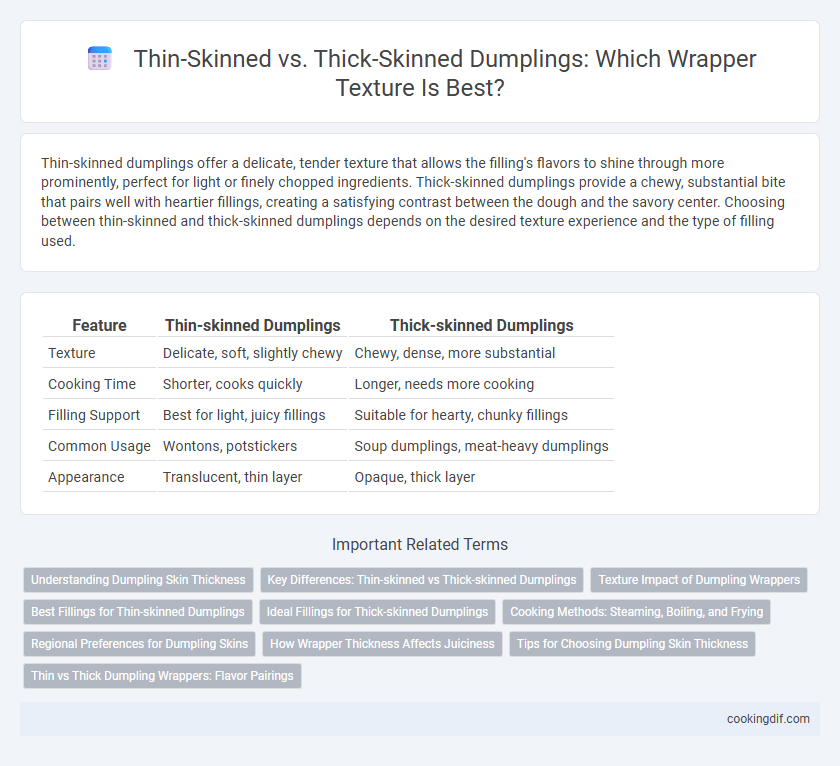Thin-skinned dumplings offer a delicate, tender texture that allows the filling's flavors to shine through more prominently, perfect for light or finely chopped ingredients. Thick-skinned dumplings provide a chewy, substantial bite that pairs well with heartier fillings, creating a satisfying contrast between the dough and the savory center. Choosing between thin-skinned and thick-skinned dumplings depends on the desired texture experience and the type of filling used.
Table of Comparison
| Feature | Thin-skinned Dumplings | Thick-skinned Dumplings |
|---|---|---|
| Texture | Delicate, soft, slightly chewy | Chewy, dense, more substantial |
| Cooking Time | Shorter, cooks quickly | Longer, needs more cooking |
| Filling Support | Best for light, juicy fillings | Suitable for hearty, chunky fillings |
| Common Usage | Wontons, potstickers | Soup dumplings, meat-heavy dumplings |
| Appearance | Translucent, thin layer | Opaque, thick layer |
Understanding Dumpling Skin Thickness
Dumpling skin thickness plays a crucial role in the overall texture and eating experience, with thin-skinned dumplings offering a delicate, tender bite that highlights the filling's flavors, while thick-skinned dumplings provide a chewier, more substantial texture that adds heartiness. Thin skins require precise dough preparation and careful handling to avoid tearing during cooking, often made from high-gluten flour for elasticity. Thick skins, typically using a mixture of flours or added starches, create a denser, more robust wrapper that stands up well to boiling, steaming, or frying, balancing texture with durability.
Key Differences: Thin-skinned vs Thick-skinned Dumplings
Thin-skinned dumplings feature delicate, translucent wrappers that offer a tender bite, enhancing the filling's flavor and texture with minimal dough interference. Thick-skinned dumplings provide a chewy, robust exterior that delivers a satisfying contrast to the savory fillings, often preferred in heartier recipes. The key differences lie in the wrapper thickness, cooking time, and overall mouthfeel, influencing the eating experience and pairing with sauces or broths.
Texture Impact of Dumpling Wrappers
Thin-skinned dumpling wrappers create a delicate, tender texture that allows the filling's flavors to shine through while offering a slight chewiness that enhances the overall eating experience. Thick-skinned wrappers provide a heartier, more substantial bite, contributing to a chewy and satisfying mouthfeel that can hold up well against robust, juicy fillings. The texture impact of dumpling wrappers directly influences the balance between wrapper and filling, altering the sensory perception and enjoyment of each bite.
Best Fillings for Thin-skinned Dumplings
Thin-skinned dumplings feature delicate, translucent wrappers that highlight the texture and flavor of finely minced fillings such as shrimp, pork with water chestnuts, and finely chopped vegetables. These fillings benefit from the thin wrapper, allowing their juiciness and subtle seasonings to shine through without being overwhelmed by dough. Optimal pairings for thin-skinned dumplings often include ingredients with a tender, juicy quality that cooks quickly and melds seamlessly with the soft, elastic texture of the wrapper.
Ideal Fillings for Thick-skinned Dumplings
Thick-skinned dumplings excel at holding hearty fillings such as braised pork, chunky vegetables, or rich mushroom mixtures, as their robust wrapper can withstand longer cooking times without breaking. This texture complements fillings that release juices during cooking, ensuring a juicy and satisfying bite. The dough's chewiness enhances the overall mouthfeel, making thick-skinned dumplings ideal for rich, savory, and moisture-heavy ingredients.
Cooking Methods: Steaming, Boiling, and Frying
Thin-skinned dumplings cook quickly and remain tender when steamed or boiled, allowing the delicate dough to complement juicy fillings. Thick-skinned dumplings hold up well to frying, creating a crispy exterior while maintaining a chewy interior texture. Steaming enhances the softness of thin skins, whereas boiling intensifies the density and chewiness of thicker skins.
Regional Preferences for Dumpling Skins
Northern Chinese dumplings typically feature thick-skinned dough, prized for its chewy texture and ability to hold hearty fillings without breaking. In contrast, Southern Chinese dumplings often use thin-skinned wrappers, emphasizing a delicate, translucent appearance that highlights the freshness of lighter fillings like shrimp or vegetables. Regional preferences influence these variations, with thicker skins favored in colder climates for their warmth and substance, while thin skins suit southern tastes for a tender, melt-in-the-mouth experience.
How Wrapper Thickness Affects Juiciness
Thin-skinned dumplings create a delicate bite that highlights the filling's juiciness by allowing steam to permeate quickly and evenly, preserving the meat's moisture. Thick-skinned wrappers provide a chewier texture but can trap moisture inside, leading to a more intense burst of juiciness upon biting. The balance between wrapper thickness and filling moisture is crucial for achieving the desired juiciness and mouthfeel in dumpling texture.
Tips for Choosing Dumpling Skin Thickness
Choosing the right dumpling skin thickness significantly impacts the texture and cooking outcome of your dumplings. Thin-skinned dumplings create a delicate, tender bite ideal for quick steaming or boiling, allowing the filling's flavors to stand out, while thick-skinned dumplings provide a chewier texture and hold up better for pan-frying or deep-frying without breaking. To select the best skin thickness, consider the cooking method and filling moisture; use thinner skins for juicy fillings and steaming methods, and opt for thicker skins for robust fillings and frying techniques to achieve the perfect balance of texture and taste.
Thin vs Thick Dumpling Wrappers: Flavor Pairings
Thin-skinned dumplings offer a delicate and chewy texture that pairs exceptionally well with light, savory fillings such as shrimp or vegetable blends, allowing the flavors to shine through without being overwhelmed. Thick-skinned dumplings provide a hearty bite suitable for robust, meaty fillings like pork or beef, as the substantial wrapper balances the richness and adds a satisfying mouthfeel. Choosing between thin and thick wrappers depends on the desired flavor intensity and texture harmony of the dumpling, enhancing the overall dining experience.
Thin-skinned vs thick-skinned for dumpling texture Infographic

 cookingdif.com
cookingdif.com